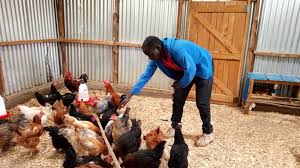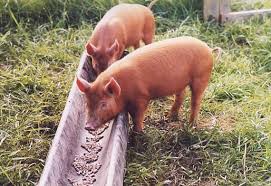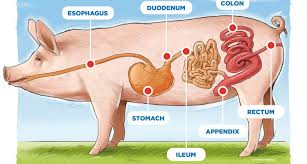The quality of feedstuffs used in compounding animal feeds largely determines the level of attainment of an animal’s productive potential. There are benchmarks that feeding different classes of poultry, swine, and rabbits must meet to satisfy the standards set for various productive stages.
Proper feeding ensures that animals remain healthy and highly productive. Adhering to these standards and management practices is essential for optimal productivity. Disease, on the other hand, represents a deviation from normal health.
One of the major challenges in livestock production is the control of diseases and parasites. Some animals are genetically resistant or susceptible to diseases and parasites. Since the inception of animal domestication, diseases and parasites have caused significant economic losses in livestock production.
These losses extend beyond animal mortality and include reduced productivity and value of surviving animals. While natural selection has been the primary method for developing disease resistance in livestock, more progress has been made in selecting disease-resistant plants than animals.
Feeding Practices for Poultry and Swine
Feeding is the act of providing feeds to animals. Feeds supply the nutrients necessary for the body’s growth, maintenance, and productivity.
Read Also: Benefits of Constructing a Fish Pond with Tarpaulin and Woods
Feeding Practice in Poultry

Environmental temperature is one of the most critical factors affecting feed intake and, consequently, body weight gain in birds. Data adapted from North and Bell (1990) illustrate the effects of house temperature on the growth and feed consumption of broilers.
For instance, an increase in house temperature from 32°C to 38°C causes a drop in feed intake of 21.3 g per bird per day and a reduction in body weight at 8 weeks of age by 290 g.
Several studies have attempted to quantify the extent to which reduced feed intake limits broiler performance at high environmental temperatures. Fuller and Dale (1979) investigated two diurnal temperature cycles: a hot cycle (24–35°C) and a cool cycle (13–24°C).
Birds were fed experimental diets ad libitum in both environments, with an additional group in the cool environment limited to the feed intake of birds in the hot environment.
The results showed that growth was depressed by 25% in birds maintained in the hot environment. When birds in the cool environment were fed the same amount of feed as those in the hot environment, their performance was reduced by only 16% compared to those fed ad libitum.
Feeding Practice in Swine

Pigs are monogastric animals and cannot efficiently digest coarse foods. Their diets typically consist of ground cereals mixed with animal and vegetable proteins, all of which have low fiber content.
Due to the increasing demand and high prices of cereal grains, as well as vegetable and animal protein sources, pig producers in Nigeria and other regions have turned to less expensive energy sources and industrial by-products such as cassava root tubers, brewer’s spent grain, and palm-kernel meal.
However, the relatively high crude fiber content of brewer’s spent grain and palm-kernel meal limits their inclusion levels in pig diets. Pigs grow and reproduce rapidly, and since they often spend their entire lives indoors, their rations require adequate mineral and vitamin supplements.
Proper feeding is essential for the maintenance and growth of sows or gilts, as well as for supporting pregnancy and milk production. The nutritional aspects of pig management involve understanding the pig’s digestive system, factors affecting digestion, feed composition, pre-treatment of feeds, and nutritional requirements during different life stages.
The formulation and balancing of nutrients in pig rations, along with effective feeding management, are crucial for efficient pork production.
Read Also: Feeding Levels for Catfish at a Water temperature of 29-30°C
Digestive System in Pig

In many ways, the physiology of digestion and absorption in the pig is similar to that of man. Like man, the pig is omnivorous, consuming food of both plant and animal origin. The alimentary tract or canal of the pig (fig. 17) extends from the lips to the anus.
Major parts of the alimentary canal are the mouth, pharynx, oesophagus, stomach, small intestine, and large intestine. Its function is to provide the necessary environment for the digestion and absorption of food.
Digestion involves the breaking down of complex foodstuffs into simpler compounds so that they can be absorbed through the wall of the intestine into the bloodstream or lymphatic system and carried to the parts of the body where they are needed.
Enzymes are chemicals which aid the process of digestion. Each enzyme is found in a particular part of the alimentary canal and aids the breakdown of a specific compound.
1. Mouth
Under natural conditions, the pig roots, i.e., it digs up soil with its snout and carries the food to its mouth using the pointed lower lip.
When pigs are not permitted to root, the food is picked up by means of the teeth, tongue, and characteristic movement of the head. In the mouth, the food is ground into a pulp by the teeth and mixed with saliva.
The enzyme ptyalin, in saliva, begins to break down the food. The food is then pushed to the back of the mouth or pharynx and passes down the oesophagus into the stomach.
2. Stomach
In the stomach, the food is churned up by the squeezing action of the muscular walls, and gastric juice is added to it. The gastric juice is produced by the gastric glands in the walls of the stomach and contains mucus, hydrochloric acid, and pepsin.
The mucus lubricates the food. The hydrochloric acid provides an acidic environment, which prevents the further action of the ptyalin from saliva and provides a suitable environment for the action of pepsin.
The pig has a simple stomach which can only digest concentrate feeds such as grains and their by-products, legumes, and other seeds and their by-products, fish, and mammalian by-products.
3. Small Intestine
In the small intestine, secretions or juices from the pancreas, liver, and small intestine complete the process of digestion. The digested food can then diffuse through the walls of the small intestine.
Pancreatic juice contains enzymes for digesting three major types of food: protein, carbohydrates, and fats. The proteolytic enzymes trypsin and chymotrypsin partially digest proteins. The enzyme pancreatic amylase hydrolyses starch to maltose.
The fats are broken down into carboxylic acids and glycerol by the action of lipase. Bile is created continually by the liver. The bile contains no digestive enzyme but is important in digestion because of the presence of bile salts, which emulsify fat globules so that they are more easily digested by lipase. Intestinal juices contain the following enzymes:
i. Several peptidases for splitting polypeptides into amino acids.
ii. Enzymes for splitting the disaccharides, sucrose, maltose, isomaltose, and lactose into monosaccharides such as glucose, fructose, and galactose.
iii. Intestinal lipase for splitting neutral fats into glycerol and carboxylic acids.
iv. Very small amounts of intestinal amylase for splitting carbohydrates into disaccharides.
4. Large Intestine
The large intestine is the site for the absorption of water into the body. It secretes mucus to lubricate the undigested food. In response to bacterial infection, it secretes large volumes of water and electrolytes. This action dilutes the irritating factors and causes rapid movement of the faeces towards the anus, resulting in diarrhoea.
Absorption
Food absorption does not take place in the mouth and oesophagus. The small intestine is the major site of food absorption. The mucus membrane of the small intestine is highly modified as an organ of absorption by the presence of a large number of tiny finger-like projections called villi.
These villi increase the surface area of the intestinal wall and so provide a large surface area for the absorption of food.
In pigs, the villi are shorter in length than in other farm animals. The absorbed foodstuffs may be transported around the body by the lymph and by the blood portal system. Fats are absorbed primarily by the lymph.
Carbohydrates and products of protein digestion, water, and inorganic salts are absorbed primarily by the blood.
Concentrates are feeds that are low in fluid and high in digestibility. They can be low in protein, e.g., maize, or high in protein, e.g., fish meal.
They can be of plant origin, e.g., soya bean meal, groundnut cake, cottonseed cake, and palm kernel cake. They can also be of animal origin, e.g., meat meal, fish meal, blood meal, etc. They can be mixed, i.e., plant and animal origin.
Roughages are feeds high in fibre content or low in digestibility. These are dry roughages, e.g., hay and straw, as well as succulent roughage, e.g., silage, roots (i.e., potato, cassava), and fodders (i.e., grasses, legumes, and leafy vegetables).
Do you have any questions, suggestions, or contributions? If so, please feel free to use the comment box below to share your thoughts. We also encourage you to kindly share this information with others who might benefit from it. Since we can’t reach everyone at once, we truly appreciate your help in spreading the word. Thank you so much for your support and for sharing!

